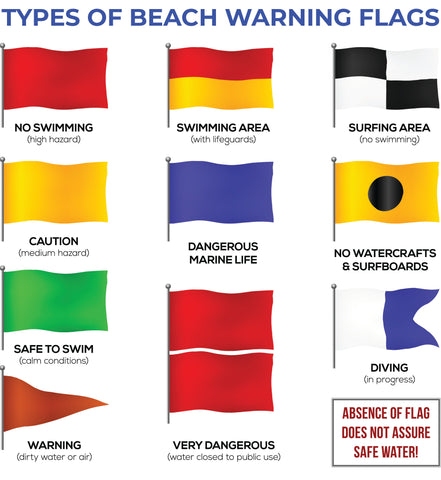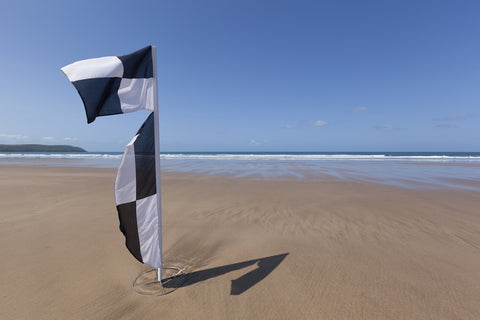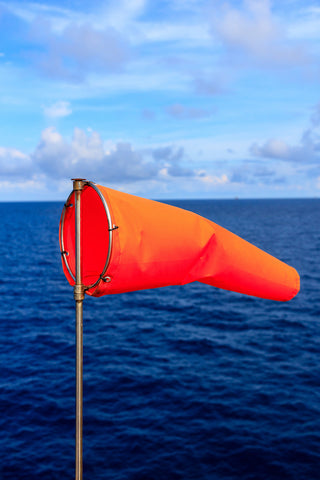
Morey Mach 7 42" Bodyboard
Morey
THE BASICS If you're looking for the perfect mid-range bodyboard, look no further. Built by Morey (the company that invented the boogie board in t...
View full detailsIn this guide, we're going to dive into the various types of beach warning flags. It's extremely important to know the types of flags before heading to the beach. Being aware of the flag types will help you be safe in the surf, and plan accordingly.
Beach safety flags are mandated by the United States Lifesaving Association and the International Life Saving Federation (for specific guidelines, you can check this link out). So luckily, it's quite standardized -- there's only a few flags to remember!
Let's jump right into the types of flags, and then note some additional beach safety guidelines and signs.


The yellow flag means that the surf presents a medium hazard. This could mean it's a rough day out in the waves, there's large waves, or there may be a small rip current. In yellow flag conditions (or really any surf conditions), we recommend adult supervision at all times.
Additionally, if you're taking your kids out in the water, always wear life vests.
Yellow flags are generally the most common type of flag seen. It's recommended that you take precautions before swimming in a yellow flag environment.

A red flag indicates that the surf is extremely dangerous. This could be due to the presence of big waves, strong rip currents, or other dangerous conditions.
You should not enter the ocean in red flag conditions unless you are a very good swimmer.
Do not enter the water with children, and always swim with a buddy if you absolutely have to go out in red flag conditions. Ultimately, this flag indicates that you should only swim at your own risk, and even then, take extreme caution when doing so.
The red flag indicates what the ILSA describes as a "High hazard."
The ILSA describes a red flag over another red flag as "[an] extremely high hazard. Water closed to public use."
This flag type is reserved for some of the most dangerous surf conditions. We strongly advise against going into waters in these conditions.
Avoid going into surf conditions with double red flags at all costs.

Very much the opposite of a red over red flag, the green flag indicates the presence of calm surf conditions.
This means it's a nice, safe day to enjoy at the beach!
Provided there's no presence of other flag types, this means it's safe to use surfboards, bodyboards, and any other type of watersports gear - just be safe with other riders and beachgoers.
Like with any beach day however, still exercise caution and supervise children.
You may not have heard of a purple flag before. This flag means that there's marine pests present.
What is a marine pest, exactly?
A marine pest could be a variety of things -- a few that come to mind are algae, jellyfish, or even sharks.
Once again with purple flags, it's swim at your own risk. If a purple flag is present, there could be some very dangerous jellyfish in the waters. We always recommend talking to your lifeguard before entering, as the type of marine pest could vary from bioluminescent algae all the way up to a Box Jellyfish.
Once again, we strongly recommend against going into purple flag conditions. A dangerous jellyfish sting can be fatal.

Unlike the other flags, the red over yellow flag does not mean something is inherently dangerous. In fact, this flag represents something to enhance your safety at the beach. A red over yellow flag signifies a recommended swimming area that has lifeguard supervision.
If available at your beach, we always recommend swimming within red over yellow flag areas. Sure, they may be a bit more crowded, but there's nothing more important than your safety at the beach.

A black and white area is designated for watercraft, rather than for swimming. Avoid swimming in watercraft areas if at all possible.
These areas are essentially dedicated surfing areas. The conditions are ripe for surfing and the flag signifies non-surfers to stay out of the area, to keep both surfers and beachgoers safe.
If you see a yellow flag with a black ball or circle in the middle, this means that watercraft use is prohibited.
Avoid surfing in these areas and using any form of watercraft.

An orange windsock indicates the presence of offshore or strong winds.
If there's an orange windsock on your beach, avoid using any type of inflatable or float.
The red and white quartered flag indicates an emergency evacuation.
There could be a variety of reasons for this, ranging from sharks in the water to hurricane conditions.
Evacuate the water immediately.
Now that you know the types of warning flags, it's important for us to take a look at some various warning signs you may see at the beach. Many of them are easy to interpret, but it's always good to take a second look at them to ensure you understand what they mean.
You can find a good list of beach warning signs here.
It's important to always supervise children and young adults. They should always be swimming with at least one adult.
If you're going out in the surf, whether to swim or to go surfboarding or bodyboarding, always go out with a buddy. This will help ensure that you're safe if you ever come into contact with a big wave or a rip current.
If at all possible, always swim, surf, and board at lifeguarded beaches, near the lifeguard post, in the designated area. If you're surfing or boarding, always go within a black and white flag. If you're swimming, stay within the red and yellow flag area.
If you come into contact with a strong rip current, and you feel confident in your ability to swim, swim parallel and gently towards the shore. Do not attempt to swim directly inwards, as you will get pulled in further.
If you're not confident in your ability to swim, raise your hand and call for help from the lifeguard, or nearby beachgoers if it is not a lifeguarded beach.
To avoid your chances of being in a rip current, always observe lifeguard flags, warning signs, and listen to instructions from local lifeguards.
If you're ever tired, heading for a session alone, or not confident in your swimming abilities, don't go out into the ocean. You never know if or when a rip current is developing, and it's always safer to stay out when you're tired then head in.
Rest up and try again the next day when conditions are better.
If it's getting dark or starting to storm, if waves are getting large, if it's getting windy or even if you hear thunder in the distance, it's time to leave the water and head home until the weather is back to normal.
It's best to stay safe and plan ahead: don't head to the beach on a day that you know it's going to storm.
Always apply sunscreen, ideally every 90 minutes or even more often. Apply 30 minutes before you head out. Ideally get sunscreen that you have to lather on, as spray sunscreens do not last as long.
Additionally, to help protect yourself from harmful UV rays, use a wetsuit or rash guard.
If you got unlucky enough to have some sunburns, treat them frequently with aloe vera gel. It'll help cool and soothe the burns.
Remember to bring some first aid supplies in your beach bag, or, at minimum, to your hotel or beach house. There's always the risk of getting cuts on shells, jellyfish stings, or swim fin rashes. You want to be able to quickly fix these issues should they arise.
If you are a newer, younger, or elderly swimmer, always swim close to the shoreline with a parent or trusted friend, and always wear a life vest or life jacket. Ideally, learn to swim at a nearby pool before heading into the ocean.
If you ever see a warning sign, or a person struggling in the surf, head over to your lifeguard and let them know. They'll be happy to assist, and you might just save someone's life.
As noted by the Red Cross, piers and jetties can be dangerous -- they often can cause permanent rip currents surrounding them. While it may look like the perfect surf spot, we would recommend staying at least 100 feet away from them. They may have good waves, but they've also got serious rip currents surrounding them, which can pose a serious danger to even the most experienced swimmers and surfers.
Here's a quick video from the Red Cross about some important beach safety tips.
Of course, these aren't the only beach safety guidelines. As always, exercise caution and ask a lifeguard if you have any questions or concerns. Bring adequate beach gear, surf together, and always wear sunscreen. This will ensure you enjoy your trip!